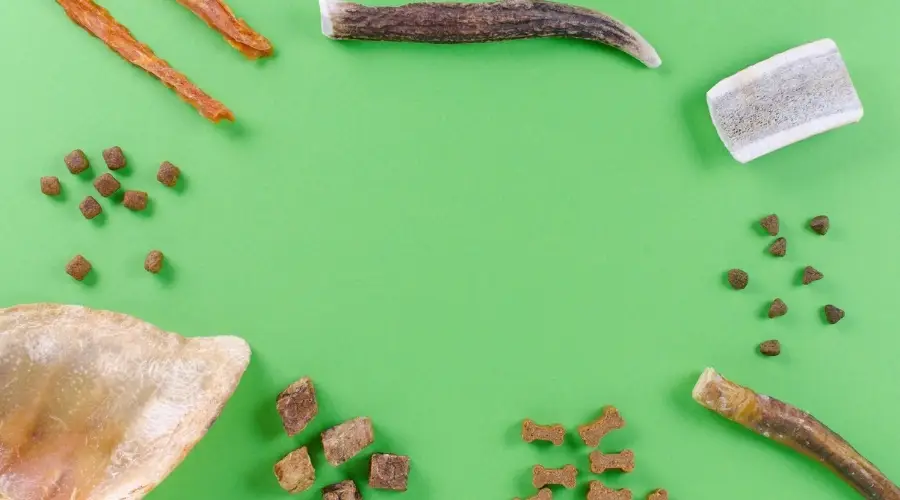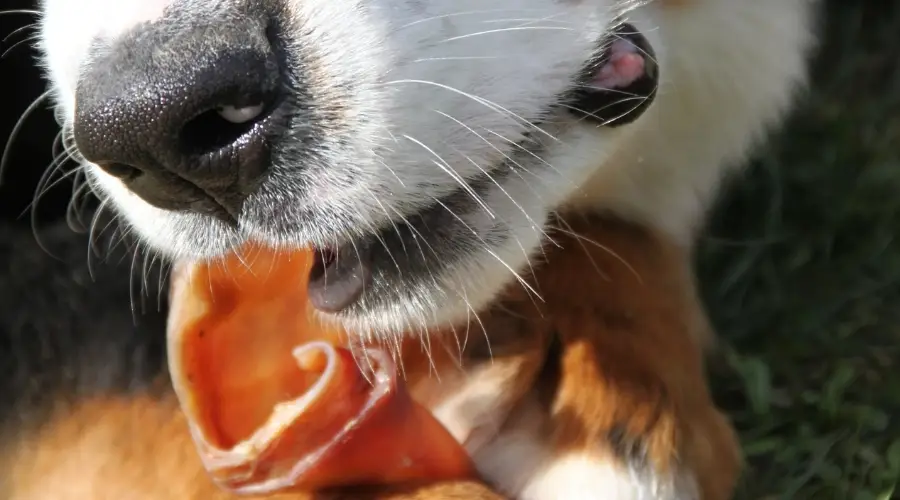
As a snack or reward, you may consider giving your dog some pig ears. Perhaps you already have, but you want to make sure that your dog can safely eat pig ears. Pig ears are safe to consume as a treat in the vast majority of circumstances. There are, however, certain things to think about before giving your puppy a pig ear to gnaw on. For a dog that is teething or an older dog that requires dental treatment, there may be better options.
Both people and dogs like a regular diet of pork. The kidneys, liver, and ears of the pig are often overlooked because they are deemed unappealing. Including them in our dogs’ regular diet is a great way to use up more of the pig. Thankfully, our canine friends aren’t as finicky eaters as ourselves. It is possible to put these nutritious portions of a healthy animal corpse to good use by including them in kibble.
Of course, you may also use certain pieces as rewards. Particularly pig ears seem to be gaining in vogue. People are increasingly interested in preparing them at home using raw materials from a local butcher, and you can get them in pet shops as prepared treats.
How Do Pig Ear Treats Get Made?

When it comes to chewing snacks, the majority of them are either baked or dried. Blanching is another possible processing step. This is when the tiny hairs on the pig’s ear are removed with a brief bath of hot water.
These hairs will not damage your dog, but eliminating them will result in a cleaner-looking final product. The majority of commercial pig ear products include nothing added during or after processing. The crunch and taste of the ears alone are enough to make them an attractive delicacy.
Do You Think I Could Make My Own?
Dogs love pigs’ ears, and you can get them pretty much everywhere. Make sure you get fresh ears from a good butcher if you’re set on making pig ears at home nonetheless. Because you’ll be handling raw meat, remember to thoroughly sanitize any surfaces that may come into touch with it.
Although some owners may be tempted to avoid cooked dog food for fear of their pet developing digestive problems or food poisoning, it is not recommended that dogs be fed raw products. And the microorganisms they pick up from their raw diet may be dangerous to humans as well. Therefore, raw feeding is not recommended, particularly for homes with young children or members who are immunocompromised.
The ears of a pig should be cooked before being fed to the animal. Regardless of whether you feed it cooked or raw, your dog will likely not have a strong preference. Ears may be prepared at home in a manner similar to that used by professional services. In order to get rid of any filth and dust that may have accumulated during transport, a clean wash is in order as soon as you get them inside your house. Blanching will act as a secondary cleaning process to get rid of any stray hair. It is then advised that the ears be roasted or dehydrated at a temperature of at least 1600F.
Is Pig Ear Treats Safe For Dogs?

The USDA reports that a single cooked pig’s ear has 29 grams of protein, 15 grams of fat, and 64 grams of water. A wide variety of nutrients, including iron, calcium, magnesium, and phosphorus, may be found in it as well. That depends on the brand and kind of cooking you use. While delicious, they all have a common trait: a calorie count of around 264 per serving. To be clear, pigs’ ears are meant to be a snack, not a regular component of the diet. Even while they will satisfy your hunger and give you some nourishment, their calorie content is too high to be considered healthy.
Therefore, unless working with a board-certified nutritionist to develop a balanced diet that includes pigs’ ears, they should only be provided on rare occasions. Your dog should only be getting 10% of his daily calories from treats like pig ear chews. Your veterinarian can help you figure out how many treats are appropriate and how many calories your dog needs each day.
Calorie counts are often listed on the packaging of commercial products. If you don’t have access to a calorie counter or are using handmade chews, you may estimate that one ear has around 264 calories. If your dog has a lower daily energy demand, you may discover that you can only give half an ear to him without exceeding his limit, or you may want to look for a product that is pre-cut and portioned.
Are They Effective for Teeth Cleaning?
There is data to suggest that utilizing a tough chew would make your teeth seem cleaner. But tartar might still be present below the gum line. Currently, there is insufficient information to conclude that any therapy may effectively ward against periodontal disease. Only treats designed to promote dental health are exempt from this rule. Regular brushing with dog-safe toothpaste is the best method to maintain your dog’s gleaming white teeth.
Is it safe to chew on a pig’s ears?
Pig ears are thought to be safe for dogs. However, there has been significant debate concerning their use in recent years. It is entirely up to you whether or not to feed your dog pig ears. However, there are a few factors to consider before feeding them to your dog, such as digestive obstructions, greater fat content, and Salmonella.
Blockages in the intestine
Dogs should be watched during playtime if pig ears are being fed as a crunchy chew toy. Pig ear chews are very hard and readily shatter into pieces. This raises the possibility of choking and intestinal blockage. If you see your dog excessively drooling or coughing during a play session, it is possible that a piece of the treat became lodged somewhere in the mouth or esophagus. This is an emergency, and you should contact your veterinarian right now.
Even if a large portion is able to pass through the stomach, the connective tissue and skin of the pig ear are difficult to digest and may be hard to break down without first being chewed. There have been stories of dogs getting pig ear parts caught in their stomachs, which need surgery to remove. If your dog will be eating pig ear chews on a daily basis, learn how to spot indicators of blockages in the gastrointestinal system. This includes vomiting, diarrhea, appetite changes, and stomach discomfort. If your dog doesn’t chew his pig ear before eating it, a different chewing reward might be a better pick for playing.
Salmonella Infection
There will be recalls from time to time, like with many other items on the market. The most recent recall came in September 2019 as a result of individuals being ill from Salmonella contamination after touching pigs’ ears treats. The treats had been sent in from overseas and were discovered to be contaminated with salmonella, which was being passed on to the individuals in the home by direct contact with the ear or via the dog.
Situations like these are excellent reminders to always wash your hands after touching your dog’s food or treats. When handling a meat product, particularly one stored at room temperature, there is always the risk of infection. The FDA works closely with pet treat producers to prevent hazardous germs from being identified in our dogs’ food and treats in the first place.
A comprehensive report and a list of items included in the most recent recall may be found on the Food and Drug Administration (FDA) website. You may utilize the FDA safety alert page to remain up to current on recalls.
Fat Content of Pig Ears
The high-fat content of pigs’ ears has been linked to pancreatitis in dogs. Certainly, certain dogs seem to be more vulnerable to this. After eating a pig’s ear, they may experience vomiting, diarrhea, and stomach discomfort. If your dog is little or has a sensitive stomach, this is more probable.
It may be more common if your dog is already on a high-fat diet or has a history of pancreatitis. Pig ears, on the other hand, might cause a negative reaction in any dog. Keep a close eye on your dog, particularly if it’s their first time having one. Obesity may also be caused by increased fat and calorie levels. This is already a significant issue for pet owners in the United States.
Are Pig Ears Good Chew Toys?

Most dogs will appreciate having something to chew on. Dogs use their mouths to investigate their surroundings. It is critical to have something to fulfill this exploratory drive in order to avoid chewing tendencies from being directed against furnishings. If your canine partner must be left alone for an extended period of time, a chew toy is an excellent approach to minimize boredom and alleviate separation anxiety.
Puppies are renowned chewers as well! They will gnaw on anything that will allow them to use their teeth. This is particularly true while their adult teeth are coming in and they are attempting to alleviate the related pain. Chew toys are absolutely something you should have on hand for your dog. Toys that will not break apart or be ingested should be avoided during unsupervised play. Toys will also be devoid of the high-calorie content seen in pig ear chews. You won’t have to worry about fitting them around the diet this way.
Is Rawhide a Better Option?
Rawhide is closely related to pigs’ ears. It is also formed of thick connective tissue from cow skins. As a result, rawhide chews must be provided with the same caution as pigs’ ears. Dogs should be checked for choking or intestinal blockage. Some rawhide goods are now made with numerous layers squeezed together to eliminate this danger.
It will be available as compressed rawhide. It will be less prone to shatter into little pieces, which might pose a health risk. Rawhide has lately come under scrutiny due to the chemicals that may be used to cure it. If you wish to give your dog a rawhide, you may reduce the danger by purchasing rawhide manufactured in the United States and inspecting the package for hidden extras.
Lower-risk choices include artificial chewing snacks that crumble or dissolve readily when consumed. Other benefits of utilizing these snacks include the fact that they are often fewer in calories than natural goods. Some are even manufactured in “weight-reducing” formulae to make them easier to include in your dog’s diet.
Most dogs will appreciate having something to chew on. Dogs use their mouths to investigate their surroundings. It is critical to have something to fulfill this exploratory drive in order to avoid chewing tendencies from being directed against furnishings. If your canine partner must be left alone for an extended period of time, a chew toy is an excellent approach to minimize boredom and alleviate separation anxiety.
Puppies are renowned chewers as well! They will gnaw on anything that will allow them to use their teeth. This is particularly true while their adult teeth are coming in and they are attempting to alleviate the related pain. Chew toys are absolutely something you should have on hand for your dog. Toys that will not break apart or be ingested should be avoided during unsupervised play. Toys will also be devoid of the high-calorie content seen in pig ear chews. You won’t have to worry about fitting them around the diet this way.
Other Healthy Options
There are various more chew-oriented choices that will give some nutritional advantages to your dog. Diced zucchini or sliced sweet potatoes are two foods we suggest. Make sure they’re all bite-sized enough for your pet to swallow after a chewing session.
You can also freeze them and defrost them slightly so your dog has something to chew on rather of simply wolfing them down as a treat. Some dog owners freeze huge pieces of pineapple or watermelon to give their dog something to gnaw on while relaxing their gums.
Last Thoughts
Pig’s ears are not the healthiest treat for your dog and may induce blockages and pancreatitis. They may also endanger people. As a result, it’s critical to adhere to all hygiene measures, such as washing your hands after handling. If you do decide to offer your dog pig’s ears, make sure they come from a reputable supplier. You should also keep an eye on your dog during reward time. Due to the high-calorie content, limit your dog’s consumption to once per week.